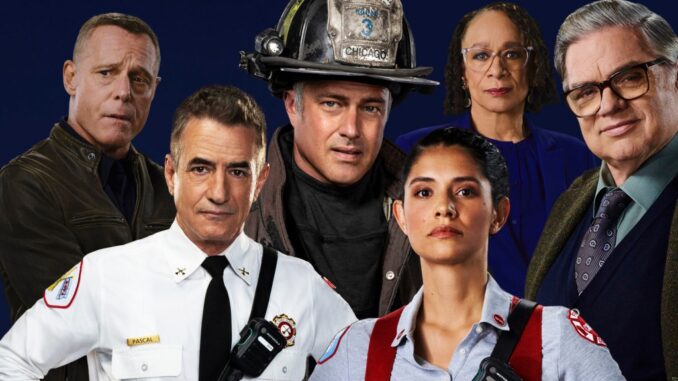
From Sirens to Scalpels: Exploring the Heart of One Chicago Through Three Key Series
Dick Wolf’s “One Chicago” universe is more than just interconnected television shows; it’s a vibrant ecosystem reflecting the pulse of a modern American city. Through the intertwined narratives of Chicago Fire, Chicago P.D., and Chicago Med, viewers are granted an intimate glimpse into the daily struggles, triumphs, and ethical dilemmas faced by those dedicated to protecting and healing its residents. While each show focuses on a distinct corner of the city’s landscape, their collective impact creates a compelling tapestry, showcasing the resilience and interconnectedness of its people. By examining these three key series, we can explore the shared themes of duty, sacrifice, and the enduring spirit of Chicago.
Chicago Fire provides a visceral entry point into this universe, anchoring itself in the heart of Firehouse 51. More than just a workplace, the firehouse is a family, bound together by the shared danger they face and the unwavering loyalty they display. We see this in the selfless actions of Lieutenant Matthew Casey, a stoic leader burdened by the weight of responsibility, and the audacious spirit of Lieutenant Kelly Severide, a charismatic rescue specialist battling personal demons. Each episode unfolds with the adrenaline-pumping intensity of burning buildings, daring rescues, and the constant threat of mortality. However, the true strength of the show lies in its exploration of the interpersonal relationships within the firehouse. From the playful banter to the heartbreaking losses, the camaraderie between these individuals provides a crucial buffer against the trauma they witness daily. Chicago Fire embodies the ideal of selfless service, highlighting the bravery and dedication required to run towards danger when everyone else is running away. It reminds us that heroism isn’t just about grand gestures, but about the everyday acts of courage, sacrifice, and unwavering support for one another.
Shifting gears, Chicago P.D. delves into the complexities of law enforcement within the city’s often-gritty underbelly. Led by the morally ambiguous Sergeant Hank Voight, the Intelligence Unit operates with a relentless focus on bringing criminals to justice, often blurring the lines between right and wrong. The show tackles challenging issues like police brutality, systemic corruption, and the ethical quandaries faced by those tasked with upholding the law. Characters like Detective Jay Halstead and Detective Hailey Upton grapple with the moral implications of their actions, constantly questioning whether the ends justify the means. Chicago P.D. doesn’t shy away from portraying the darkness that exists within the city, exploring the psychological toll it takes on its officers. It forces viewers to confront uncomfortable truths about the complexities of justice and the often-difficult choices that law enforcement officials must make. Unlike the more straightforward heroism of Chicago Fire, Chicago P.D. presents a more nuanced and often unsettling perspective, raising critical questions about the balance between protecting the community and upholding individual rights.
Finally, Chicago Med offers a window into the high-pressure environment of Gaffney Chicago Medical Center, where doctors and nurses face life-or-death decisions on a daily basis. The show presents a diverse array of medical cases, ranging from routine ailments to complex traumas, highlighting the incredible skills and unwavering dedication of the medical professionals within its walls. Dr. Will Halstead, an emergency room physician driven by a strong sense of compassion, and Dr. Natalie Manning, a pediatrician navigating the complexities of single motherhood, represent the heart of the medical staff. Chicago Med explores the ethical dilemmas inherent in modern medicine, from issues of resource allocation to the challenges of treating patients with limited access to care. It delves into the emotional toll of witnessing human suffering firsthand, highlighting the resilience and empathy required to thrive in such a demanding environment. More than just a medical drama, Chicago Med is a testament to the power of human connection and the unwavering commitment to healing that drives its characters. It reminds us of the vital role healthcare professionals play in our society, and the extraordinary sacrifices they make to ensure the well-being of their patients.
In conclusion, the interconnected narratives of Chicago Fire, Chicago P.D., and Chicago Med paint a comprehensive portrait of the city. Each series, while focusing on a distinct professional sphere, grapples with universal themes of duty, sacrifice, and the importance of human connection. From the roaring flames of a burning building to the sterile halls of a bustling hospital, the “One Chicago” universe reminds us that even in the face of adversity, the spirit of Chicago endures, fueled by the unwavering dedication of its everyday heroes. The strength of these series lies not just in their individual narratives, but in their collective ability to capture the heart and soul of a vibrant American city, reminding us that even in the midst of chaos, hope and resilience can always be found.
